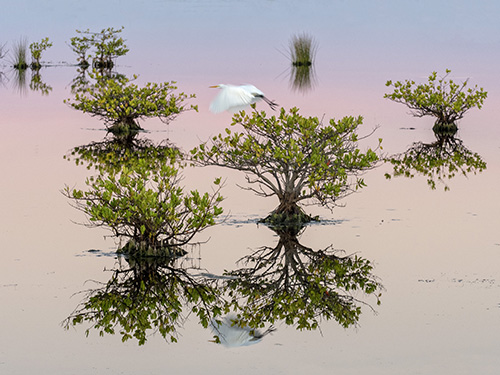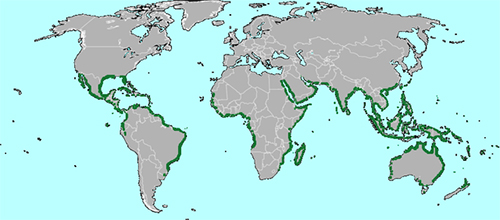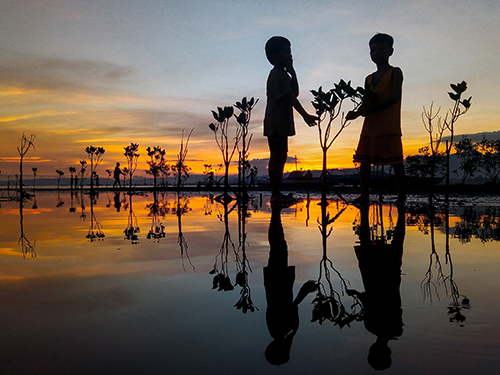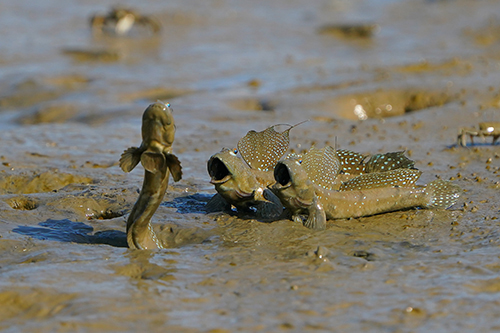Navigation
Mangrove Action Project Collaborates to Restore and Preserve Mangrove Ecosystems
Two successful MAP projects ...are Nai Nang Village in Thailand, and the Bay of Jiquilisco in El Salvador. In both, after the initial Community-based Ecological Mangrove Restoration (CBEMR) training and restoration, the projects and conservation have been locally driven and shaped as a result of working together.
Sir David Attenborough, People's Advocate for #COP26, Address to World Leaders | Climate Action
The worldwide response to COP26 from individual actions to major organizations and governments, has been seen as a sign of hope, at least by this author. For example, on November 6, 2021, at the start of COP26, Canterbury Cathedral’s Cathedral Garden, a daily online service directed to people of all faiths worldwide, Dean Robert Willis took the opportunity afforded by his widely popular morning prayers to feature David Attenborough’s poignant assessment of the conditions of the planet and to call to attention some successful initiatives including the Mangrove Action Project.
David Attenborough said “...ten thousand years ago, Earth was home to an estimated 6 trillion trees...By the end of the last century that number had halved...as we are fast discovering, by removing forests we are harming biodiversity and ourselves.
“In order to have chance of keeping below 1.5 degrees of global warming we need to value the service that healthy forests can provide... Services such as absorbing vast amounts of carbon from the atmosphere, cleaning the air we breathe, and providing fresh water, inspiring immense spiritual and cultural value as well as underpinning healthy food systems and generating new economic opportunities.”
Among the less well-known and smaller forests of the world, are mangrove forests, productive wetlands also known as mangrove swamps, mangrove thickets or mangals, according to Wikipedia. Mangrove trees are fascinating. From the surface, you often see only intricate leaf filled branches. Below, there is an incredible abundance of life swimming among long twisted roots reaching down into the bottom of the sea floor.
Mangroves at Dawn
 Mangroves at Dawn: A peaceful early morning moment at the Merritt Island National Wildlife Refuge in Florida. Photograph by MAP photography contest Runner Up Melodi Roberts of the USA
Mangroves at Dawn: A peaceful early morning moment at the Merritt Island National Wildlife Refuge in Florida. Photograph by MAP photography contest Runner Up Melodi Roberts of the USA
According to NASA, https://earthobservatory.nasa.gov/images/47427/mapping-mangroves-by-satellite, “mangroves cover an estimated 137,760 square kilometers (53,190 square miles) of Earth’s surface.
 Global map of mangroves by NASA
Global map of mangroves by NASA
"Such coastal forests can be found in 118 countries and territories, though nearly 75 percent of their area occurs in just 15 countries. They are most often found straddling the equator between 25° North and South latitude. About 42 percent of the world’s mangroves are found in Asia, with 21 percent in Africa, 15 percent in North and Central America, 12 percent in Australia and the islands of Oceania, and 11 percent in South America...Nearly a fifth of the coast of Australia is edged by mangroves. Australia has the third largest area of mangroves in the world (after Indonesia and Brazil), and approximately 6.4 percent of the world’s total mangrove area.”
Why Mangroves? The importance of mangrove forests
Mangrove Action Project’s successful efforts and its videos describing the importance of mangrove trees, a couple of which Horizon has included in this article, were written in cooperation with the Mangrove Action Project (MAP).
The “Mangrove Action Project works with a variety of local and international entities to help ‘preserve, restore, and educate on our global mangrove forests.’” The importance of mangrove forests is well recognized by hundreds of millions of individuals around the world who depend on the vital resources provided by mangrove forests for their livelihoods and safety from erosion. Mangroves support biodiversity from spawning fish life to migrating birds.
 Adaptation of the Bengal Tiger: “After 4 days of tracking the elusive Bengal Tiger, we were finally able to predict where this individual might cross a creek. These big cats have adapted to life in the mangroves, and shadow through creeks and channels in search of prey.” Photograph by MAP photography contest winner Arijit Das of India
Adaptation of the Bengal Tiger: “After 4 days of tracking the elusive Bengal Tiger, we were finally able to predict where this individual might cross a creek. These big cats have adapted to life in the mangroves, and shadow through creeks and channels in search of prey.” Photograph by MAP photography contest winner Arijit Das of India
With the heightened awareness of the need for planet-wide efforts to address climate change, as MAP states, mangroves are recognized for their role in “mitigating climate change (both through massive carbon sequestration potential, and in dealing with current effects like coastal erosion).”
Mangrove Propagators
 Mangrove Propagators: “The sun sets on a stretch of coastline after a mangrove restoration and beach clean took place within the local community.” Photograph by MAP photography contest Winner Mark Kevin Badayos of the Philippines
Mangrove Propagators: “The sun sets on a stretch of coastline after a mangrove restoration and beach clean took place within the local community.” Photograph by MAP photography contest Winner Mark Kevin Badayos of the Philippines
“By working with forest communities, research academics, forest and environment departments, policy makers, and international policy and funding groups, we encourage the preservation and conservation of existing mangroves, educate on how to restore degraded or unhealthy mangrove ecosystems, and encourage multiple generations to take an active interest in their local forests. Why do we do this? Because healthy mangroves can provide coastal communities (particularly the poorest) with a sustainable living and reduce their vulnerability to disasters from natural events such as hurricanes and storm surges. Mangroves also provide a host of other benefits to the world at large – including sequestering and storing more carbon than any other forest type per hectare.”
Asked “Which projects have been most successful and why do you think they have achieved success?” Leo Thom, the Creative Director of MAP, replied: “For me, our most successful projects have come about through local relationships and long-term collaborations. We know our methodologies of mangrove restoration (Community-based Ecological Mangrove Restoration) bring back full biodiversity where there has been mangrove loss. But for it to be fully successful, there has to be local communities or local partners implementing it and taking ownership of their regenerating mangroves.
“Two MAP projects that stand out for me are Nai Nang Village in Thailand, and the Bay of Jiquilisco in El Salvador. In both, after the initial CBEMR training and restoration, the projects and conservation have been locally driven and shaped as a result of working together.”
“Since 2010, MAP has been restoring mangrove forests with Nai Nang village on the Andaman Coast who have now become experts in beekeeping and mangrove conservation. By building bee boxes and placing them close to the forest, bees have helped improve mangrove restoration efforts through pollination. This led to the creation of a local enterprise whose members now implement sustainable beekeeping practices, including a reduction in pesticide use, which facilitates healthy native bee populations, develops raw honey products, and promotes community-based mangrove conservation. News of Nai Nang’s successful project has spread among the region, and they are now training other coastal communities so that they too can adopt this sustainable livelihood model, protecting their mangroves, keeping bees, and producing honey products.”
 Dancing Mudskipper: "The two mudskippers were stunned during a fight for territory, by a playful dancing individual. These amphibious fish live in mudflats and connected mangrove ecosystems." Photograph by MAP photography contest Runner Up Leo Liu of Singapore
Dancing Mudskipper: "The two mudskippers were stunned during a fight for territory, by a playful dancing individual. These amphibious fish live in mudflats and connected mangrove ecosystems." Photograph by MAP photography contest Runner Up Leo Liu of Singapore
A major project of MAP is “Enhancing understanding of mangrove ecology and stakeholder needs to improve project outcomes for coastlines and communities,” through its Mangrove Action Project which offers workshops on ‘Community-based Ecological Mangrove Restoration’ (CBEMR) methodology.
The CBEMR method applied to mangrove projects introduces holistic, cost-effective approaches to mangrove restoration. “CBEMR addresses the underlying mangrove stressors and reasons for previous mangrove loss, as well as methods to identify and fix the present biophysical and socio-economic situation to produce a sustainable, biodiverse mangrove forest that provides the full suite of ecosystem services.”
For example, in 2011 Mangrove Action Project led a successful workshop with partners EcoViva on Community Based Ecological Mangrove Restoration (CBEMR) alongside the Mangrove Association. This included a three-day training workshop to help the community restore their lost mangrove forests.
Community-Based Ecological Mangrove Restoration Training
The work resulted in the Minister of Environment, Sr. Rosa Chavez, declaring the community led EMR method as the one to follow in El Salvador's National Environmental Plan for mangrove conservation and restoration. The locally-led mangrove conservation is still very active today including restoring abandoned shrimp ponds, and the formation of The Mangrove Alliance, which is a coalition of community-based conservation organizations concerned with protecting the mangrove forests of Mesoamerica (Mexico and Central America).
The “Marvelous Mangroves” Curriculum
More from MAP:
CBEMR Intro for Enquirers 6 viii 2020.pdf
The Golden Rules for Mangrove Planting (Eng).pdf
Suggested reading: Pause before you Plant_Final MSG.pdf Advice published by the IUCN Mangrove Specialist Group
https://mangroveactionproject.org/2021/01/27/stingless-bees-for-improving-mangrove-biodiversity/
https://mangroveactionproject.org/2021/03/10/first-stingless-bees-back-into-the-mangroves/
https://ecoviva.org/mangrove-restoration-beginning-to-bear-fruit/
MAP suggests: “For an excellent source of general mangrove knowledge and resources, please also visit mangroverestoration.com.
Resources on the Horizon International Solutions Site
Horizon has included many articles about mangroves over the years which are available on the Solutions Site, and provides a video from Horizon International’s filming of marine preservation in Bonaire, Fish Life in Mangroves Bonaire, seen above, which is available on YouTube at https://youtu.be/Qhl9un7He9I.
Among its articles is on published in 2010, the New World Mangrove Atlas highlighted the state of mangrove trees, their ecological and economic importance. The article about the Atlas on the Solutions Site provides a glimpse into significant features of these invaluable, threatened ecosystems:
New World Mangrove Atlas Highlights Importance of and Threats to Mangroves and Successful Restoration Efforts, available at https://www.solutions-site.org/node/429
Published on the Horizon International Solutions Site on January 2, 2022.
Written by Janine M H Selendy with the thoughtful cooperation of the MAP.
Search
Latest articles
Agriculture
- World Water Week: Healthy ecosystems essential to human health: from coronavirus to malnutrition Online session Wednesday 24 August 17:00-18:20
- World Water Week: Healthy ecosystems essential to human health: from coronavirus to malnutrition Online session Wednesday 24 August 17:00-18:20
Air Pollution
- "Water and Sanitation-Related Diseases and the Changing Environment: Challenges, Interventions, and Preventive Measures" Volume 2 Is Now Available
- Global Innovation Exchange Co-Created by Horizon International, USAID, Bill and Melinda Gates Foundation and Others
Biodiversity
- It is time for international mobilization against climate change
- World Water Week: Healthy ecosystems essential to human health: from coronavirus to malnutrition Online session Wednesday 24 August 17:00-18:20
Desertification
- World Water Week: Healthy ecosystems essential to human health: from coronavirus to malnutrition Online session Wednesday 24 August 17:00-18:20
- UN Food Systems Summit Receives Over 1,200 Ideas to Help Meet Sustainable Development Goals
Endangered Species
- Mangrove Action Project Collaborates to Restore and Preserve Mangrove Ecosystems
- Coral Research in Palau offers a “Glimmer of Hope”
Energy
- Global Innovation Exchange Co-Created by Horizon International, USAID, Bill and Melinda Gates Foundation and Others
- Wildlife Preservation in Southeast Nova Scotia
Exhibits
- Global Innovation Exchange Co-Created by Horizon International, USAID, Bill and Melinda Gates Foundation and Others
- Coral Reefs
Forests
- NASA Satellites Reveal Major Shifts in Global Freshwater Updated June 2020
- Global Innovation Exchange Co-Created by Horizon International, USAID, Bill and Melinda Gates Foundation and Others
Global Climate Change
- It is time for international mobilization against climate change
- It is time for international mobilization against climate change
Global Health
- World Water Week: Healthy ecosystems essential to human health: from coronavirus to malnutrition Online session Wednesday 24 August 17:00-18:20
- More than 400 schoolgirls, family and teachers rescued from Afghanistan by small coalition
Industry
- "Water and Sanitation-Related Diseases and the Changing Environment: Challenges, Interventions, and Preventive Measures" Volume 2 Is Now Available
- Global Innovation Exchange Co-Created by Horizon International, USAID, Bill and Melinda Gates Foundation and Others
Natural Disaster Relief
- STOP ATTACKS ON HEALTH CARE IN UKRAINE
- Global Innovation Exchange Co-Created by Horizon International, USAID, Bill and Melinda Gates Foundation and Others
News and Special Reports
- World Water Week: Healthy ecosystems essential to human health: from coronavirus to malnutrition Online session Wednesday 24 August 17:00-18:20
- STOP ATTACKS ON HEALTH CARE IN UKRAINE
Oceans, Coral Reefs
- World Water Week: Healthy ecosystems essential to human health: from coronavirus to malnutrition Online session Wednesday 24 August 17:00-18:20
- Mangrove Action Project Collaborates to Restore and Preserve Mangrove Ecosystems
Pollution
- Zakaria Ouedraogo of Burkina Faso Produces Film “Nzoue Fiyen: Water Not Drinkable”
- "Water and Sanitation-Related Diseases and the Changing Environment: Challenges, Interventions, and Preventive Measures" Volume 2 Is Now Available
Population
- "Water and Sanitation-Related Diseases and the Changing Environment: Challenges, Interventions, and Preventive Measures" Volume 2 Is Now Available
- "Water and Sanitation-Related Diseases and the Changing Environment: Challenges, Interventions, and Preventive Measures" Volume 2 Is Now Available
Public Health
- Honouring the visionary behind India’s sanitation revolution
- Honouring the visionary behind India’s sanitation revolution
Rivers
- World Water Week: Healthy ecosystems essential to human health: from coronavirus to malnutrition Online session Wednesday 24 August 17:00-18:20
- Mangrove Action Project Collaborates to Restore and Preserve Mangrove Ecosystems
Sanitation
- Honouring the visionary behind India’s sanitation revolution
- Honouring the visionary behind India’s sanitation revolution
Toxic Chemicals
- "Water and Sanitation-Related Diseases and the Changing Environment: Challenges, Interventions, and Preventive Measures" Volume 2 Is Now Available
- Actions to Prevent Polluted Drinking Water in the United States
Transportation
- "Water and Sanitation-Related Diseases and the Changing Environment: Challenges, Interventions, and Preventive Measures" Volume 2 Is Now Available
- Urbanization Provides Opportunities for Transition to a Green Economy, Says New Report
Waste Management
- Honouring the visionary behind India’s sanitation revolution
- Honouring the visionary behind India’s sanitation revolution
Water
- Honouring the visionary behind India’s sanitation revolution
- Honouring the visionary behind India’s sanitation revolution
Water and Sanitation
- Honouring the visionary behind India’s sanitation revolution
- Honouring the visionary behind India’s sanitation revolution

